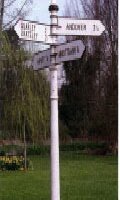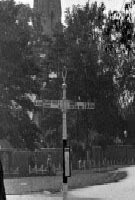Traditional Direction Signs


The purpose of this leaflet is to provide advice on the use of traditional direction signs, on the repair and conservation of existing examples, and guidance on their reintroduction in appropriate locations. This leaflet was published by the Department for Transport in 2005.
Introduction
Traditional direction signs make a very important contribution to the local character and identity of suburbs, villages and rural areas across the country. Sometimes called fingerposts, they are a cherished part of the traditional image of the English countryside and suburban fringe. The wide variety of surviving regional and local designs helps to reinforce local distinctiveness and maintain a sense of continuity. They are attractive items of street furniture that should be retained, repaired, and reintroduced where appropriate.
This leaflet includes a section on the historical background of direction signs, the current regulations and planning policy. It also contains information about the conservation and repair of traditional direction signs, the installation of new direction signs and listing.
Funding Sources
The leaflet also identifies possible sources of funding for the repair of traditional fingerposts, including the Heritage Lottery Fund grant scheme, Local Heritage Initiative (LHI). Since the publication of this leaflet the LHI scheme has closed but there are some possible alternative sources of funding:
- The Heritage Lottery ‘Awards for All’ scheme. Check the Heritage Lottery Fund website for more information.
- Grass Roots Grant Scheme. Funding for schemes identified as important by small local voluntary and community groups where they have an annual income below £20,000.
- For repair of traditional fingerposts in National Parks or AONBs the National Park and AONB sustainable development fund. Check the National Parks website for details of funding priorities and local contact details.
Summary
- Traditional direction signs make a major contribution to local distinctiveness and rural identity. Their repair and maintenance can be important to the local economy by supporting craftsmanship and helping to provide local jobs.
- Existing examples should be retained and regularly maintained as part of an integrated approach to local authorities' highways and planning functions.
- Wherever appropriate, traditional fingerposts can be reintroduced on rural roads other than ‘A’ and ‘B’ classified roads to reinforce local identity, for example where some fingerposts are already in use in an area and new ones can provide an adequate level of service and safety. Duplicate or unnecessary additional signs should be removed to reduce clutter.
- Where fingerposts are reintroduced, only upper case lettering should be used. Where pre-1964 fonts are to be used on replacement signs, authorisation must be sought from the Department for Transport.
- Responsibility for the maintenance and repair of fingerposts and other historic street furniture should be clarified and local authorities should maintain a register of sites.
What's New?
-
The National Heritage List for England is now live on the English Heritage website.
-
Welcome to the HER21 page. This page offers access to the full suite of HER21 project reports.
